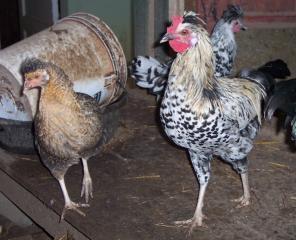Quote:
Cynthia,
I think I did not do a good enough job writing my explanation.
Males that carry two barring genes will almost always (can not say always because stuff happens) give a barring gene to each of its offspring. So barred males almost always father barred offspring. Somewhere in my writing I did not do a good job of explaining this concept. Which you already know. I write many times not only for active writers but spectators.
The barring gene does an excellent job of placing a white bar on an extended black bird, like the barred rock.
The problem with the barring gene is that it will also cause the color of a red bird to become a buff color. I have experienced this in the production of my barred rhode island red. Sometimes it is difficult to see the barring on the females. Like in Cuban longtails birds.
I have males that only contain one barring gene. This allows me to see the potential color in some of the hens. One half of the hens are barred and buff. The other half of the hens are dark mahogany red.
The barring gene is a very good diluter of any pigment-red or black. With red pigment, the barring dilutes the red pigment any where on the bird. (Black is a different story. Not going anywhere with that concept.) So, you wind up with a buff bird that should be a much darker color.
I am currently working on barring on different genetic combinations. Should be interesting. So far I am disappointed in the results but i can not make the genes do something they were not designed to do. Next spring I may be singing a different tune.
The columbian gene only plays a part in adding more silver or gold ( having the columbian gene): less silver or gold to a bird ( not having the columbian gene).
Tim
PS. The almost always thing on the barring- I had a male that had two barring genes produce a non barred female. I went through all of the things that could have caused the anomaly and I eliminated all of the possible causes of the problem. See stuff happens. Something turned off the barring gene or the barring gene was defective. All I know is that it happened.
Cynthia,
I think I did not do a good enough job writing my explanation.
Males that carry two barring genes will almost always (can not say always because stuff happens) give a barring gene to each of its offspring. So barred males almost always father barred offspring. Somewhere in my writing I did not do a good job of explaining this concept. Which you already know. I write many times not only for active writers but spectators.
The barring gene does an excellent job of placing a white bar on an extended black bird, like the barred rock.
The problem with the barring gene is that it will also cause the color of a red bird to become a buff color. I have experienced this in the production of my barred rhode island red. Sometimes it is difficult to see the barring on the females. Like in Cuban longtails birds.
I have males that only contain one barring gene. This allows me to see the potential color in some of the hens. One half of the hens are barred and buff. The other half of the hens are dark mahogany red.
The barring gene is a very good diluter of any pigment-red or black. With red pigment, the barring dilutes the red pigment any where on the bird. (Black is a different story. Not going anywhere with that concept.) So, you wind up with a buff bird that should be a much darker color.
I am currently working on barring on different genetic combinations. Should be interesting. So far I am disappointed in the results but i can not make the genes do something they were not designed to do. Next spring I may be singing a different tune.
The columbian gene only plays a part in adding more silver or gold ( having the columbian gene): less silver or gold to a bird ( not having the columbian gene).
Tim
PS. The almost always thing on the barring- I had a male that had two barring genes produce a non barred female. I went through all of the things that could have caused the anomaly and I eliminated all of the possible causes of the problem. See stuff happens. Something turned off the barring gene or the barring gene was defective. All I know is that it happened.






